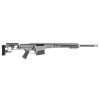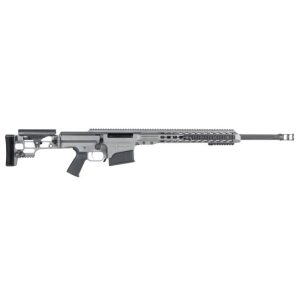Barrett Firearms MRAD .338 Lapua Mag Bolt Action Rifle, Flat Dark Earth Cerakote – 14374 For Sale
$5,970.98
The Barrett MRAD .338 Lapua Mag Bolt Action Rifle exemplifies precision and modularity, ideal for competition and duty use. Featuring a durable Flat Dark Earth Cerakote finish, its core is a monolithic upper receiver crafted from 7000-series aluminum, incorporating a full-length M1913 Picatinny top rail designed for superior long-range accuracy. The adaptable handguard provides slots for accessory mounting, while its standout user-changeable barrel system allows quick conversion between eight calibers or various barrel lengths with just a Torx wrench. The rifle includes a fully adjustable match-grade trigger module, compact folding stock, and ambidextrous design elements such as a paddle-style magazine release and swappable thumb safety, accommodating all shooters. Additional features are a push-button length of pull adjustment, height-adjustable polymer cheekpiece, polymer bolt guide, 20 MOA optics rail, high-efficiency muzzle brake, and a relief cut magazine well for rapid reloading. This rifle’s multi-mission capability delivers exceptional performance from the range to the battlefield.
Can civilians buy Barrett-Mrad?
Yes, civilians can purchase the Barrett MRAD, as it is a bolt-action rifle available for civilian sale in the United States, provided that buyers comply with federal, state, and local laws governing firearms purchases. It’s important for potential buyers to ensure they meet all legal requirements, which may include background checks and obtaining necessary permits.
What is the range of the Barrett Mrad 338?
The Barrett MRAD (Multi-Role Adaptive Design) chambered in .338 Lapua Magnum typically has an effective range of approximately 1,500 to 1,900 meters (about 1,640 to 2,080 yards), depending on various factors such as ammunition type, environmental conditions, and shooter proficiency.
What is the effective range of a .338 Lapua Magnum rifle?
The effective range of a .338 Lapua Magnum rifle is typically around 1,500 meters (approximately 1,640 yards). However, experienced marksmen can achieve even greater distances, sometimes up to 1,800 meters (about 1,970 yards) or more, under optimal conditions.
Who makes the best 338 Lapua Magnum rifle?
Determining the “best” .338 Lapua Magnum rifle can be subjective and depends on individual needs, preferences, and intended use. However, several manufacturers are renowned for producing high-quality .338 Lapua Magnum rifles:
1. **Accuracy International** – Known for their precision and reliability, the Accuracy International AXMC is a popular choice among military and law enforcement as well as long-range shooting enthusiasts.
2. **Sako** – The Sako TRG 42 is highly praised for its exceptional accuracy, build quality, and advanced features, making it a top choice for precision shooters.
3. **Barrett** – Famous for their expertise in long-range weaponry, Barrett offers models like the MRAD that are well-received for their adaptability and precision.
4. **Desert Tech** – The Desert Tech HTI is another contender, known for its compact design and modular capabilities, appealing to tactical shooters.
5. **Blaser** – The Blaser R8 is admired for its innovative design and precision, offering versatility with different barrel options.
Ultimately, what makes a rifle “best” depends on your specific requirements, such as tactical features, weight, price, and personal preference in handling and shooting accuracy. It’s advisable to try out different models or consult with experts to find the best fit for your needs.
Is it legal to own a 50 cal sniper rifle?
The legality of owning a .50 caliber sniper rifle depends on the specific laws and regulations of the country, state, or region where you reside. In the United States, for example, ownership of a .50 caliber sniper rifle is generally legal in most states; however, there are exceptions and certain regulations that must be followed, such as background checks, age requirements, and restrictions on certain types of ammunition.
In other countries, the laws may vary significantly. Some countries may have strict regulations or outright bans on the possession of firearms like .50 caliber rifles.
It’s important to research and understand the specific laws applicable to your location and consult with local authorities or legal experts if you have any questions or concerns.
Is the MRAD a good rifle?
The MRAD (Multi-Role Adaptive Design) by Barrett is generally considered a high-quality rifle. Designed for versatility and precision, it is widely used by military forces, law enforcement, and competitive shooters. It features modular components, allowing it to be adapted for different calibers and missions. The rifle is known for its accuracy, durability, and advanced design, making it a favorable choice among experts. However, like any firearm, its suitability depends on specific user needs and preferences.
What sniper rifle has the longest range?
The sniper rifle known for having the longest effective range is the CheyTac M200 Intervention. It is chambered in .408 CheyTac and is renowned for its accuracy and capability to engage targets at extreme distances, reportedly up to 2,500 yards (approximately 2,286 meters) or more under optimal conditions.
What does Barrett Mrad stand for?
As of my last update, there is no widely recognized or prominent entity, concept, or meaning associated with the term “Barrett Mrad.” It might be a name or a term specific to a certain context or field. If this is a recent or highly specific development, checking the latest sources or context-specific information might help clarify its relevance.
What is the difference between 338 Lapua and 338 Norma?
The .338 Lapua Magnum and the .338 Norma Magnum are both high-caliber rifle cartridges used for long-range shooting, but they have some key differences:
1. **Origin and Purpose**:
– The .338 Lapua Magnum was developed in the 1980s by Lapua and was designed for military snipers to engage targets at long distances.
– The .338 Norma Magnum was developed later, in the early 2000s, partly to compete with the .338 Lapua. It aims to offer similar or better performance in a more compact form.
2. **Case Dimensions**:
– The .338 Lapua has a slightly longer case with a length of about 93.5 mm (3.68 inches) compared to the .338 Norma, which is about 89.26 mm (3.51 inches) in length. This difference affects the overall cartridge length and sometimes the magazine and action size required.
3. **Performance**:
– Both cartridges are capable of similar ballistic performance, often pushing bullets in the 250-300 grain range at similar velocities. However, the .338 Norma tends to achieve this performance with slightly shorter action, which can translate to a lighter and more compact rifle design.
4. **Availability and Usage**:
– The .338 Lapua is more widely used and recognized, both in military and civilian long-range shooting communities. The .338 Norma has been gaining traction, especially among competitive shooters and some military forces interested in its potential advantages in specific configurations.
5. **Rifles and Compatibility**:
– Many rifles are chambered for the .338 Lapua, given its longer history and established use. The .338 Norma is becoming more available but still less common than the .338 Lapua.
In summary, while both cartridges offer excellent long-range performance, the choice between them often comes down to specific needs related to rifle size and usage preference.
What sniper did Chris Kyle use?
Chris Kyle primarily used the McMillan TAC-338 sniper rifle and the Mk 12 Special Purpose Rifle during his time as a Navy SEAL sniper.
How much does a 338 Lapua drop at 1000 yards?
The bullet drop of a .338 Lapua Magnum at 1,000 yards can vary depending on several factors, including the specific bullet weight, muzzle velocity, ballistic coefficient, and environmental conditions such as altitude, temperature, and humidity. However, a common estimate for a 250-grain bullet with a muzzle velocity around 2,900 feet per second and a ballistic coefficient of about 0.675 might show a drop of approximately 300 inches (or 25 feet) at 1,000 yards in standard atmospheric conditions. For precise calculations, using a ballistic calculator with specific data tailored to the shooting conditions is recommended.
Is a 338 Lapua too big for deer?
The .338 Lapua Magnum is a powerful cartridge that is often considered overkill for deer hunting. It is designed for long-range shooting and can take down much larger game, such as elk or moose, with ease. Using this caliber for deer hunting could result in excessive meat damage due to its high power and energy. For most deer hunting scenarios, a more typical cartridge like the .243 Winchester, .270 Winchester, or .30-06 Springfield would be more appropriate and sufficient for an ethical and clean kill.
Can civilians own military grade weapons?
The ability for civilians to own military-grade weapons varies widely depending on the country and its specific laws and regulations. In many countries, owning military-grade weapons is either heavily restricted or outright prohibited for civilians.
In the United States, for example, federal law regulates the ownership of certain military-grade weapons through the National Firearms Act (NFA), which requires registration and taxation of weapons like machine guns, silencers, and short-barreled rifles or shotguns. Civilians can own these weapons, but they must comply with strict regulations, background checks, and approvals. Some states have additional laws that further restrict or prohibit owning such weapons.
In contrast, many other countries have much stricter gun control laws that largely prevent civilian ownership of military-grade firearms.
Always check the specific laws and regulations in your jurisdiction to understand what is permitted and what is not.
Who can buy a ghost gun?
The legalities surrounding the purchase of ghost guns, which are firearms that are privately made and lack serial numbers, vary within the United States and around the world. In the U.S., federal law does not outright ban individuals from buying or making ghost guns for personal use, provided they are legally allowed to own firearms. However, recent regulatory changes by the Bureau of Alcohol, Tobacco, Firearms and Explosives (ATF) aim to tighten restrictions by requiring serial numbers on some DIY kits and imposing background checks.
State laws also come into play, and some states have enacted stricter regulations banning the sale or ownership of ghost guns altogether or requiring serialization and background checks. Therefore, whether an individual can legally buy or make a ghost gun depends on both federal and state laws, which can change fairly frequently. It’s important for individuals to be aware of current regulations in their jurisdiction.
Can a civilian own a TAC 50?
Yes, a civilian in the United States can legally own a TAC-50 rifle, as it is a bolt-action firearm and not classified under the National Firearms Act as a restricted weapon. However, ownership is subject to federal, state, and local laws and regulations regarding firearms. Potential buyers must comply with background checks and other legal requirements as applicable in their jurisdiction.
| Product Line | MRAD |
|---|---|
| Action | Bolt |
| Magazine Type | Polymer Relief Cut Drop Free |
| Stock | Adjustable Folding Right Side |
| Trigger Type | Fully Adjustable |
| Muzzle Type | Muzzle Brake |
| Twist | 1 |
| Hand Orientation | Right |
| Safety | Thumb Operated, Ambidextrous |
| Receiver Material | Aluminum |
| Stock Material | Synthetic |
| Receiver Finish | Flat Dark Earth Cerakote |
| Stock Finish | Flat Dark Earth Cerakote |
| Overall Length | 47.4" |
| Barrel Type | Fluted |
Be the first to review “Barrett Firearms MRAD .338 Lapua Mag Bolt Action Rifle, Flat Dark Earth Cerakote – 14374” Cancel reply
Related products
Barrett MRAD .338 Lapua Mag
Barrett Firearms MRAD .338 Lapua Mag Bolt Action Rifle, Tungsten Gray Cerakote – 14386



Reviews
There are no reviews yet.